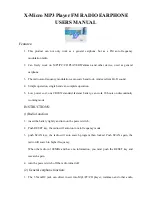
MDS 05-3438A01, Rev. F
MDS 4790/9790 Series I/O Guide
G-1
GLOSSARY
Active Messaging
—This is a mode of diag-
nostic gathering that may interrupt SCADA
system polling communications (contrast with
passive messaging
). Active (or intrusive) mes-
saging is much faster than passive messaging
because it is not dependent upon the RTU
polling cycle.
BERT
—Bit-error rate test. The results of a
BERT are normally expressed as a ratio (power
of 10) of the number of bits received in error
compared to the total number received.
BER
—Bit-error rate. See also BERT.
Bit
—Binary digit. The smallest unit of digital
data, often represented by a one or a zero. Eight
bits usually comprise a byte.
bps
—Bits-per-second. A measure of the infor-
mation transfer rate of digital data across a
communication channel.
Byte
—A digital “word” usually made up of
eight bits.
dBi
—Decibels of gain relative to an isotropic
radiator. (A hypothetical antenna which radi-
ates equally in all directions.) Used to express
antenna gain.
dBm—
Decibels relative to one milliwatt. An
absolute unit used to measure signal power, as
in transmitter power output or received signal
strength.
DCE
— Data (circuit terminating) Communi-
cations Equipment. In data communications
terminology, this is the “modem” side of a
computer-to-modem connection. The trans-
ceiver board is a DCE device which is designed
to connect to a DTE device.
Decibel (dB)
—A measure of the ratio between
two signal levels. Frequently used to express
the gain or loss of a system.
DSP
—Digital Signal Processing. Advanced
circuit technique to increase radio perfor-
mance, primarily in modulation and demodula-
tion.
DTE
—Data Terminal Equipment. In data com-
munications terminology, this is the computer
side of a computer-to-modem connection.
(Connects to the DCE device.)
Fade Margin
—The maximum tolerable reduc-
tion in received signal strength which still pro-
vides an acceptable signal quality. This
compensates for reduced signal strength due to
multipath, slight antenna movement or
changing atmospheric losses. Expressed in
decibels.
Frame
—A segment of data that adheres to a
specific data protocol and contains definite
start and end points. It provides a method of
synchronizing transmissions.
Fresnel Zone
—A point of maximum width or
girth of the transmitted radio signal. Obstruc-
tions in this region (the “first Fresnel zone”)
can have a detrimental effect on reception
quality. As a general rule, 60 percent of the first
Fresnel zone should be free of obstructions in a
well-designed system. (Additional consider-
ations are required when planning an RF path.
A detailed discussion of the subject is presented
earlier in this manual.)
Half-Power Beamwidth
—The customary
way of measuring the width of a directional
antenna’s radiation pattern. This beamwidth is
measured in degrees between the half-power
points (the point at which the power is reduced
3 dB with respect to the main beam).
RSPSupply - 1-888-532-2706 - www.RSPSupply.com
http://www.RSPSupply.com/p-8457-MDS-UP-9790X.aspx












































